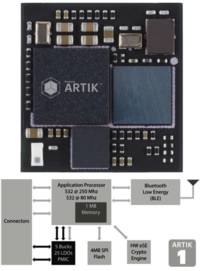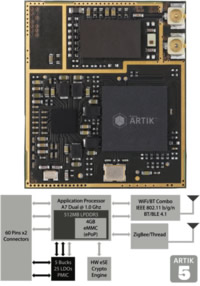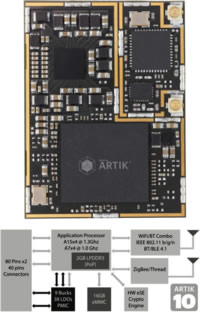
Samsung Details New Artik Chipset for IoT Devices
Samsung is trying attract developers of Internet-Of-Things devices with the release of the Artik family of chips, produced specifically for connected devices and data. ARTIK is an open platform that includes a amily of integrated production-ready modules, software, development boards, drivers, tools, security features and cloud connectivity.
"We are providing the industry?s most advanced, open and secure platform for developing IoT products", said Young Sohn, president and chief strategy officer, Samsung Electronics. "By leveraging Samsung?s high-volume manufacturing, advanced silicon process and packaging technologies, and extensive ecosystem, ARTIK allows developers to rapidly turn great ideas into market leading IoT products and applications."
All members of the Samsung ARTIK family - Artik 1, 5 and 10) incorporate embedded hardware security technology, on-board memory and processing power in an open platform. Security is also a key element of the software integrated into the module along with the ability to connect to the Internet for cloud-based data analytics and enhanced services. As an open platform, Samsung ARTIK can be customized:
- The ARTIK 1 is a very compact IoT module. At just 12mm-by-12mm, it combines Bluetooth/BLE and a nine-axis sensor with extremely low power consumption.
- The ARTIK 5 delivers a balance of size, power and price-performance. It has been designed for use in home hubs, drones and high-end wearables. It incorporates a 1GHz dual-core processor and on-board DRAM and flash memory.
- The ARTIK 10 brings the performance and capabilities from Samsung?s flagship Galaxy phones to IoT with an eight-core processor, full 1080p video decoding/encoding, 5.1 audio and 2GB DRAM along with 16GB flash memory. The Samsung ARTIK 10 includes Wi-Fi, Bluetooth/BLE and ZigBee connectivity and is designed for use with home servers, media applications, and in industrial settings
 |
 |
At the hardware level, ARTIK contains am embedded secure element that goes beyond what software-based encryption solutions can provide alone. At the application level, ARTIK is equipped with a machine learning based anomaly detection system. This allows the user to identify abnormalities and unusual behavior in order to address possible hacking or intrusion activity.
Samsung?s ARTIK platform comes with an IoT software stack and development tools needed to kick-start the development of products. Developers can go directly to application framework development, instead of spending time building low-level software libraries.
ARTIK also supports local storage and computational capabilities that in most current IoT environments are generally only addressable by large-scale cloud servers. Depending on user requirements, data can be managed locally or in the cloud in encrypted or unencrypted formats.
The ARTIK platform offers low power consumption to enable longer battery life for battery operated IoT devices like wearables. The platform includes a tiered architecture that allows applications and tasks to run at the right power-optimized performance and memory utilization.
All ARTIK modules use next generation ePoP (embedded Package-on-Package) technology developed by Samsung Electromechanics.
Also at IoT World today, Alex Hawkinson, founder of Samsung?s SmartThings subsidiary unveiled plans for the SmartThings OpenCloud Platform. The cloud-based software allows all devices capable of connecting to the Internet to interact with each other.
The open software platform allows the sharing of diverse data sets from an unlimited number of sources. This vast amount of data can then be broken up into smaller chunks for visualization and analysis. The software works with any operating system and without regard to the source or structure of data. The end result of providing applications and services with access to such a wide array of information is the potential to deliver new insights and new forms of discovery.
The SmartThings OpenCloud Platform allows device makers to focus on building IoT devices and applications without having to build and maintain the cloud infrastructure required to connect those devices.
ARTIK 1 |
ARTIK 5 |
ARTIK 10 |
|
| APPLICATION PROCESSOR | Dual Core @250MHz + @80MHz |
ARM A7 Dual @ 1GHz |
ARM A15x4@1.3GHz + A7x4@1.0GHz |
| MEMORY | 1MB on-chip + 4 MB SPI Flash |
512MB LPDDR3 + 4GB eMMC |
2GB LPDDR3 + 16GB eMMC |
| DISPLAY | WVGA (800*480) |
TBD |
|
| PMIC | 5 Buck converters + 25 LDOs |
9 Buck converters + 38 LDOs |
|
| OS | Nucleus OS |
Yocto 1.6 OS (Fedora) |
|
| DEVELOPMENT ENVIRONMENTS |
|
|
|
| DIMENSIONS | 12mm x 12mm |
29 x 25 x 3.5 mm |
39 x 29 x 3.5 mm |
| HW + SW SECURITY |
|
|
|
| WIFI | - |
802.11 b/g/n |
|
| BLUETOOTH | - |
BT/BLE |
|
| ZIGBEE | - |
Yes |
|
| External Interface | |||
| GPIO | - |
47 (2 PWM output including) |
51 (2 PWM output including) |
| ANALOG CAPTURE | - |
2 (0 ? 1.8V range) |
6 (0 ? 1.8V range) |
| UART | - |
2 |
3 ( FLOW CONTROL 1 PORT) |
| I2C | - |
4 |
6 |
| SPI | - |
1 |
|
| I2S | - |
1 |
|
| USB | - |
1 |
1 USB 2.0 HOST + 1 USB 3.0 |
| MMC | - |
1 (T Flash) |
|
| MIPI | - |
1 DSI (2 LANE) + 1 CSI (2 LANE) |
|
| CLOCK OUT | - |
1 - 24MHz + 1 - 32.768KHz |
|
| INPUT POWER | - |
3.4V ? 5.0V |
|
| OUTPUT POWER | - |
1.8V/100mA + 2.4V/100mA |
|
| CONNECTORS | - |
|
|
| HW Audio Codec | - |
HW 5.1 Channel I2S + TDM up to 8 Channels + HW mixer |
|
| HW VIDEO CODEC | - |
HW Encoder & Decoder H.263/H264/MPEG-4/VP8 (720p)@30fps and decoding of MPEG-2/VC1/Xvid |
1080p@120fps H.263/H.264/ MPEG-4/VP8 + MPEG-2/VC1 decoding |
| GPU | - |
|
|
| NETWORK | - |
|
|






















